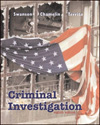1
A) Better training of arson investigators B) Cooperation with arson investigators C) Recognition and resource enhancement D) Recognition of the problem 2
A) Clean the premises of debris. B) Determine how the fire started. C) Determine the point of origin. D) Determine whether the cause was accidental. 3
A) It can point to arson. B) It helps the insurance adjuster handle fire claims. C) It can help determine the cause of the fire. D) Both A and C are correct. 4
A) Two or more distinct points of origin. B) The fire started in a closet. C) The fire started in the middle of a large room. D) All of the above. 5
not a common accidental or natural cause of fire?A) Electric system B) Gas C) Sunlight D) Spontaneous ignition 6
A) Electric system fires B) Spontaneous heating C) Heating unit fires D) Spontaneous ignition 7
not a burn indicator?A) Alligatoring B) Depth of char C) Sunlight D) Broken glass 8
A) Alligatoring B) Depth of char C) Crazing D) Spalling 9
not a variable when determining the rate of wood charring?A) Ratio of surface area to mass B) Ventilation effects C) Crazing D) Rate and duration of heating 10
A) It is a layering technique. B) It is used to estimate the duration of a fire. C) It is one of the factors needed to cause fire. D) None 11
A) Crazing B) Depth of char C) Alligatoring D) Spalling 12
A) Striking matches B) Gasoline C) Chemicals D) Electrical appliances 13
A) Determine the motives of the arsonist. B) Determine the point of origin. C) Temperature determination D) None of the above 14
A) Labor-management grievances B) Eliminating business competition C) Extracting extortion payments D) All of the above 15
A) Bankruptcy B) Loans C) Tax lien D) Code violations 16
A) Creditors B) Lien-holder C) Loan shark D) Insurance adjusters 17
A) For-profit arsonists B) Vandals C) Loan shark D) Pyromaniacs 18
A) For-profit arsonists B) Vandal fire-setter C) Female fire-setter D) Pyromaniac 19
not a method used to detect fire accelerants at a fire scene?A) Olfactory detection B) Catalytic combustion detection. C) Gas liquid chromatograph D) Interviews 20
A) Did you see any people entering or leaving the building before the fire? B) Was there evidence that an accelerant was used? C) Who is the insured party? D) Were you able to determine the cause of the fire? 21
A) Did you see any people entering or leaving the building before the fire? B) Was there evidence that an accelerant was used? C) Who is the insured party? D) Were you able to determine the cause of the fire? 22
A) Collect evidence B) Secure the scene C) Search the area D) Establish an outer perimeter. 23
A) One and one-quarter times the distance of the piece of the farthest debris found B) One and one-half times the distance of the piece of the farthest debris found C) Search the area before establishing a perimeter. D) A scene perimeter is not necessary. 24
A) Safety, general crime scene, scene documentation, evidence collection B) Safety, scene documentation, evidence collection, specialized C) Safety, general crime scene, scene documentation, evidence collection, specialized D) Safety, scene documentation, evidence collection 25
A) Suspend search operations within 300 feet and leave the object untouched. B) Move the object from the area. C) Cut the wires. D) Place it in water.



 2002 McGraw-Hill Higher Education
2002 McGraw-Hill Higher Education